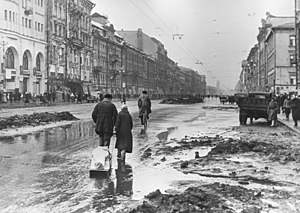Battle of Leningrad
| Siege of Leningrad | |||||||
|---|---|---|---|---|---|---|---|
| Part of the Eastern Front of World War II | |||||||
 Leningraders on Nevsky Prospect during the siege, 1942 |
|||||||
|
|||||||
| Belligerents | |||||||
|
|
|
||||||
| Commanders and leaders | |||||||
|
|
|
||||||
| Strength | |||||||
| 725,000 | 930,000 | ||||||
| Casualties and losses | |||||||
|
1942: 267,327 total casualties (KIA, WIA, MIA) 1943: 205,937 total casualties (KIA, WIA, MIA) 1944: 21,350 total casualties (KIA, WIA, MIA) Total: 579,985 casualties |
332,000 killed and 111,000 missing Civilians: 642,000 during the siege, 400,000 at evacuations |
||||||
| the Siege of Leningrad | |
|
|
|
|
|
The Siege of Leningrad, also known as the Leningrad Blockade (Russian: блокада Ленинграда, transliteration: blokada Leningrada) was a prolonged military blockade undertaken mainly by the German Army Group North against Leningrad, historically and currently known as Saint Petersburg, in the Eastern Front theatre of World War II. The siege started on 8 September 1941, when the last road to the city was severed. Although the Soviets managed to open a narrow land corridor to the city on 18 January 1943, the siege was only lifted on 27 January 1944, 872 days after it began. It was one of the longest and most destructive sieges in history and possibly the costliest in terms of casualties.
Leningrad's capture was one of three strategic goals in the German Operation Barbarossa and the main target of Army Group North. The strategy was motivated by Leningrad's political status as the former capital of Russia and the symbolic capital of the Russian Revolution, its military importance as a main base of the Soviet Baltic Fleet, and its industrial strength, housing numerous arms factories. By 1939 the city was responsible for 11% of all Soviet industrial output. It has been reported Adolf Hitler was so confident of capturing Leningrad that he had invitations printed to the victory celebrations to be held in the city's Hotel Astoria.
Although various theories have been put forward about Germany's plans for Leningrad, including renaming the city Adolfsburg (as claimed by Soviet journalist Lev Bezymenski) and making it the capital of the new Ingermanland province of the Reich in Generalplan Ost, it is clear Hitler's intention was to utterly destroy the city and its population. According to a directive sent to Army Group North on 29 September, "After the defeat of Soviet Russia there can be no interest in the continued existence of this large urban center. [...] Following the city's encirclement, requests for surrender negotiations shall be denied, since the problem of relocating and feeding the population cannot and should not be solved by us. In this war for our very existence, we can have no interest in maintaining even a part of this very large urban population." Hitler's ultimate plan was to raze Leningrad to the ground and give areas north of the River Neva to the Finns.
...
Wikipedia
